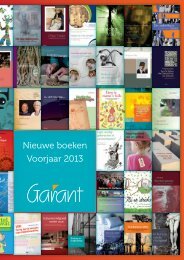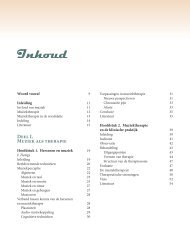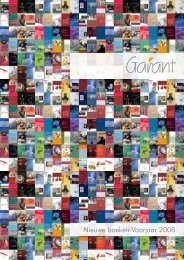Catalogus Maklu Uitgevers 2012
Catalogus Maklu Uitgevers 2012
Catalogus Maklu Uitgevers 2012
You also want an ePaper? Increase the reach of your titles
YUMPU automatically turns print PDFs into web optimized ePapers that Google loves.
44 7. CRIMINOLOGIE – Strafrecht<br />
EULOCS – the EU level offence classification system –<br />
brings together the current EU substantive criminal law acquis,<br />
building essentially on offence definitions referred to<br />
in legal instruments included in the EU JHA acquis. In<br />
doing so, EULOCS clarifies the scope between EU competence<br />
and national sovereignty with regard to defining criminal<br />
behaviour. With this book, EULOCS is<br />
bench-marked as a reference index for serving various<br />
needs in the broader EU criminal policy area, having the<br />
potential to significantly enhance the internal coherence<br />
thereof. The proposed reference index, with offence definitions<br />
inherent to it, fundamentally addresses the problem<br />
created by the organic elaboration and adoption of legal instruments<br />
at EU level, making reference to certain offence<br />
categories the scope or definition whereof is most often either<br />
not clarified or indicated, or left to the discretion of the<br />
individual member state(s).<br />
Developing an EU level offence classification<br />
system<br />
EU study to implement the Action Plan to measure<br />
crime and criminal justice<br />
Reeks IRCP nr. 34<br />
A. Mennens, W. de Wever, A. Dalamanga, A. Kalamara, G.<br />
Kazlauskaité, G. Vermeulen & W. De Bondt<br />
978-90-466-0265-2 | 2009 | 114 p. paperback | € 38,00<br />
One of the main deficiencies in the EU area of freedom, security<br />
and justice, is the lack of crosscountry comparable data<br />
on crime and criminal justice. The importance of progress in<br />
this domain, especially in the context of the identification of<br />
best practices in the fight against crime, has been identified<br />
on several occasions. The main difficulty lies in the comparability<br />
of data, or in other words the guarantee that exchanged<br />
data is understood in the same way by all actors. In March<br />
2007, the European Commission, DG JLS, launched a call<br />
for tender for a “Study on the development of an EU level<br />
offence classification system and an assessment of its feasibility<br />
to supporting the implementation of the Action Plan to<br />
develop an EU strategy to measure crime and criminal justice”<br />
– The Crime Statistics Project (CSP). This book contains<br />
the final report of that Project, conducted by Unisys Belgium<br />
and IRCP in the course of 2008-2009.<br />
EU quality standards in support of the fight<br />
against trafficking in human beings and sexual<br />
exploitation of children<br />
Exploratory study of the potential and feasibility of self-regulation<br />
or public-private co-operation<br />
Reeks IRCP nr. 33<br />
G. Vermeulen<br />
978-90-466-0116-7 | 2007 | 444 p. gebrocheerd | € 65,00<br />
This book presents the results of a research project conducted<br />
for the European Commission, aimed at enhancing the<br />
prevention of trafficking in human beings and sexual exploitation<br />
of children.The rationale for the project was to prepare<br />
possible self-regulation or publicprivate co-operation in<br />
several sectors by establishing tailor-made European quality<br />
<strong>Maklu</strong><br />
www.maklu.be<br />
standards for the respective sectors and testing the feasibility<br />
of their introduction.The sectors under study were: employment<br />
organisations, marriage bureaus, travel, escort, au-pair<br />
or adoption agencies, telecommunication and internet service<br />
providers, prostitution and pornography.<br />
Mensenhandel in beeld<br />
Eerste kwantitatieve en kwalitatieve analyse van<br />
Belgische slachtofferdata<br />
Reeks IRCP nr. 32<br />
G. Vermeulen, E. Van den Herrewegen, L. Van Puyenbroeck<br />
978-90-466-0115-0 | 2007 | 487 p. gebrocheerd | € 59,50<br />
België beschikt – als enige land in Europa – over een databank<br />
(binnen het Centrum voor Gelijkheid van Kansen en<br />
voor Racismebestrijding) waarin systematisch gegevens van<br />
alle op het grondgebied geregistreerde slachtoffers van mensenhandel<br />
worden bijgehouden. Dit boek bevat de allereerste<br />
kwantitatieve analyse van deze gegevens. Via literatuurstudie<br />
en interviews met slachtoffers en sleutelfiguren hebben de<br />
auteurs vervolgens de cijfermatige analyse verder kwalitatief<br />
aangevuld, gekaderd en genuanceerd.<br />
Recreatie en (strafbare) overlast<br />
Reeks IRCP nr. 31<br />
G. Vermeulen, S. Van Malderen<br />
978-90-466-0122-8 | 2007 | 521 p. gebrocheerd | € 65,00<br />
Dit boek spitst zich toe op (strafbaar) overlastgenererend gedrag<br />
in uitgaansgelegenheden en – buurten, in recreatiedomeinen,<br />
op speelpleinen, op ontmoetingsplaatsen in de<br />
openbare ruimte, alsook op overlast ingevolge straatracen. De<br />
onderzoekers plaatsen de verstoring van vrijetijdsbesteding<br />
door overlast in perspectief, door dieper in te gaan op die gedragingen<br />
die als overlast worden ervaren en een profiel te<br />
schetsen van de veroorzakers ervan. In functie van een adequaat<br />
en genuanceerd overlastbeleid worden bestaande initiatieven<br />
onder de loupe genomen en ‘goede praktijken’<br />
geïdentificeerd.<br />
The European pharmaceutical sector and crime<br />
vulnerabilities<br />
Reeks IRCP nr. 30<br />
T. Vander Beken<br />
978-90-466-0106-8 | 2007 | 218 p. gebrocheerd | € 43,60<br />
The influence of organised crime on business activities, enterprises<br />
and economic sectors is a matter of concern for<br />
many policy makers across the world. As a profit driven criminal<br />
activity, organised crime operates in an environment<br />
which is not limited to the underworld economy alone. Assessments<br />
of the threat posed by organised crime and strategic<br />
(preventive) actions to tackle this phenomenon require an<br />
understanding of the vulnerable spots in the legal economy<br />
that are or might be exploited by crime. Both vulnerability<br />
study and methodological tool are intended as a guide for actions<br />
and initiatives to be taken by governments, law enforcement<br />
bodies and economic players.











